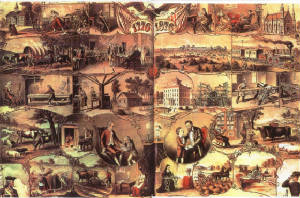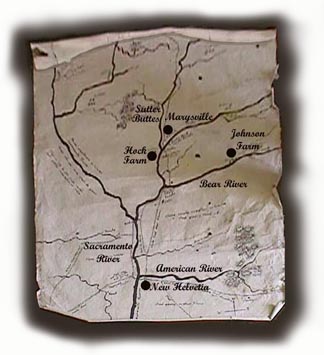|
Primary Source Images

|
| (Remember this image? It doesn't tell us anything about Socialism!) |
1. How and Why We Select Images
Rationale: We make PowerPoint
presentations, and ask our students to do the same. How often do we think about why we choose the images we choose.
Do we ask our students to choose their images with a purpose in mind? We discussed this at the seminar by looking
at images from the Progressive Age. We then discussed a Progressive Age assignment that culminated
with a slideshow assessment.
Progressive PowerPoint Project - this link contains all the needed sources and instructions to complete the lesson discussed at the seminar.

|
| Centennial Mirror |
2. Changing
American Values
Rationale: Victorian
values became significant in the mid-19th century. It would surprise
many to find out just how free American society was before Victorian values made us more prim and proper (Bill Bryson’s
Made In America has an excellent chapter on changing sexual mores in America – if you want to broach this subject
with your students, this would be an excellent reference).
By using the Copley image, and contrasting it with the Darby image, or simply by using the Centennial Mirror, you can show
your students how values had changed from the mid-1700s to the mid-1800s.
Online Resources:
3. Industry
and Maps
Rationale: Maps didn’t always look like today’s maps. Maps used to
be more like images and could tell us a lot about the place they represented. This lesson simply uses two images - one
of New York City in 1865, and one in 1905. By comparing the two images we should be able to ascertain the effect of
industry and immigration on New York City.
Online Resources:
You
will need to do a search for New York City.

4. Using ONE image to teach - "Creating the Museum"
"The Freedman's Bureau! (1866), "Reconstruction" (1867) "Sunday Morning in the Mines"
(1872)
The image to your left comes from the Harpweek.com "Political Cartoons 1776-1876" website.
Remember, you can find this image by going to the Harpweek.com "Political Cartoons 1776-1876" website. Be sure to click on the year 1866 and look for the "Freedman Bureau" cartoon. This image shows what many Americans thought was WRONG with Reconstruction, and hints at the gaining strength of the Democratic Party.
The same website above has the image "Reconstruction" that we looked at earlier in the seminar.
Again, click on 1866-1870, and look for the right image. You'll enjoy just browsing all of the images in the 1860-1870
time frame!
Don't forget, Charles Christian Nahl painted Sunday Morning in the Mines and it too serves as an excellent "one image tells it all" story of what life at the mines was like.
 5. Local Images - local images are sometime the easiest
way to hook our students. The problem has always been locating them. With the "Images of America" series, our
chances of finding meaningful, historical images of our communities just became better. Most online dealers have these
books. I've included the Amazon.com link which gives you many choices of used and new versions:
Images of America at Amazon.com: Click on the image at left to be taken
to Amazon.com (you will want to put your own city into the search)
How to Choose Primary Sources
1. Leading Questions in U.S. History
To use SOAP and the Primary Source Toolbox effectively, you need to guide your
students with a "leading question". Many states encourage the use of "leading questions" (New York Standards refer to
them as essential questions) Follow the links below to see different examples of leading questions:
Leading Questions (Kevin Williams) - I created this list of leading questions to give teachers an idea of how broad leading questions can be.
Questions are organized chronologically and by thematic unit.
New York Social Studies Curriculum - standards for 7th and 8th grade curriculum. You'll need to scroll down to page 19. While these are the middle
school standards, I've found the essential questions quite helpful. New York's high school standards do not contain
"essential questions".
2. The Olive Branch Petition and the Unity of the Revolution
Rationale: This
one document sheds a tremendous amount of light on the idea of Revolution in the colonies.
Many people assume that the Stamp Act set into motion a series of events that inevitably led to revolution. This one document disputes that argument.
Online Resources:

3. Using Statistics as Primary Sources
Rationale: One excellent skill for students to develop is the ability to find meaning in statistics
and charts.
The first example relates to Colonial Wethersford, Connecticut and the real prevalence of democracy there. These
statistics were taken from the 1976 DBQ – which brings up another point. Always
feel free to doctor documents to your needs. The original 1976 DBQ is TOO long
and tedious. These few documents make the point.
Example Two - Comparing Settlers to Jamestown and Boston:
When teaching early colonization it may be easier to impress upon your students the differences in the two colonies
if you allow them to investigate WHO went to the areas:
1. List of Jamestown inhabitants - 1607
2. Winthrop Fleet to Boston - 1630
Example Three - The Doomsday Clock and the Cold War:
1. Summary Site at Wikipedia (includes Doomsday Graph)
2. Bulletin of the Atomic Scientists (includes all the times the clock has been changed!)
For Further Enrichment - Using Electoral Statistics as a Learning Tool
The following website is an excellent (and easy to use) website that has large maps of the most recent presidential
elections. These maps are easy visuals to understanding the political makeup of much of the country.
270 to Win - use the pull down menu to navigate between the latest elections.

4.
Minstrel Music in the 1800s
Rationale: The most popular form of music
in the United States during most of the nineteenth century was blackface minstrelsy. Since its beginnings in the 1830s, most
minstrel performers were white men who pretended to be African-American singers and dancers. Minstrelsy promoted images of
African Americans that were based more on the fantasies of the white performers than on the realities of black culture and
experiences. Minstrel shows presented derogatory, stereotypical images of African Americans as unintelligent, ugly, and often
violent. By the late nineteenth century, many African-American performers also participated in the blackface minstrel industry,
since the only opportunities available to them within national theater circuits involved donning burnt cork and performing
racist caricatures. Some, but not all, African-American performers and songwriters attempted to challenge the racist caricatures
of blackface from the minstrel stage.
Many minstrel songs were published
and sold as sheet music. With close examination, this printed music can give us a number of clues about the stereotypes prevalent
in minstrelsy, the history of the music publishing industry, and the politics of the era.
Online Resources:
Click for Stephen Foster's minstrel music (click on "Foster the Songwriter")
Click for Minstrel images
Click for Minstrel images and music # 2 -This site is produced in Germany, and now has its pages in English as well
as German! The images are great too! NEW - mp3 music has been added - just click on "Blackface Songs" at the top of
the page.

5. John Sutter and Sacramento
Rationale: Many (especially those
of us who teach in California)
are well aware of the historical role John Sutter played in the early settlement of California, and later, the discovery of gold. But
how did this Swiss immigrant acquire such a large land grant? What did Sutter's Fort
look like? Students may find it interesting to read the letter of introduction that Sutter gave to Governor Alvarado
of the Mexican province of California.
Looking at images of Sutter's Fort may help students understand the purpose of Sutter's Fort in the mid 1800s.

|
| (Click for larger version of image) |
6. Primary Source Case Studies and Debates -
The Trail of Tears and The Decision to Acquire the Philippines
7. Differing Viewpoints on Vietnam / Comparison to Iraqi War
Rationale: Currently, many people are drawing parallels between the War on Terror and the Vietnam War. While politicians may disagree over the handling of the current situation in Iraq, there is agreement that
terrorism is an issue that must be dealt with. Similarly, while not everyone
agreed on how to wage the Vietnam War, most politicians agreed that it should be fought.
It is important for students to understand that this agreement crossed partisan lines. Below you will find sources
detailing our involvement, but also sources debating our involvement in Iraq in the early 21st century - this was
a significant topic during the 2004 campaign.
Online Resources:
Click for
"The American Experience: Vietnam"
Click for the article: "Kerry Remarks at the Unity Conference"
Click for George Bush's 2004 Republican Nomination Acceptance speech

|
| Alexander Zudin, Obshaya Gazeta, St. Petersburg, Russia |
Compare and Contrast the similarities and differences between Herb Block's "Ascent
into the Unknown" and Alexander Zudin's cartoon about the War on Terror.

|

